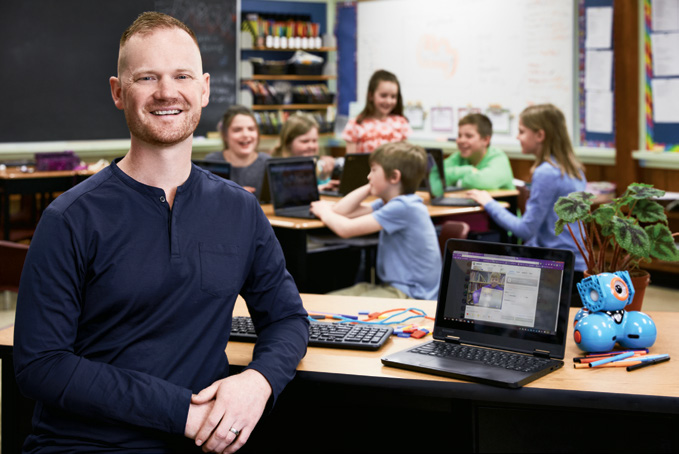Share this page
Grade 4 and 5 students in Blackstock, Ont., use video recording technology to develop math skills and more.
By Stefan Dubowski
Photo: Matthew Liteplo

The Challenge: Help students understand place value in mathematics.
The Solution: Have students record videos in which they explain place value.
Lessons Learned: Ryan Tindale, OCT, wanted to give his students a new way to learn the concept of place value in math — i.e., the value a digit has depending on where it appears in the number (ones, tens, hundreds and so on).
This Grade 4/5 teacher at Cartwright Central Public School in Blackstock, Ont., often found that while students could put numbers in the right columns when using value charts, they struggled to explain why the numbers belonged there, or what the different columns meant.
Tindale used Flipgrid (Flipgrid.com), a video discussion recording application to help students work out their own understanding of place value. The teacher logs into the class Flipgrid account to post a question for the students to answer — in this case, he asked them to explain place value. Once he posts the question, Flipgrid generates a code accessible from any device capable of running the app. From there, students enter the code, read the question and, when ready, hit “record” to capture their answers, up to 90 seconds long. When they’re finished and they’ve saved and submitted their recordings, Tindale can go back into the program to review the responses.
Observations: Tindale says the technology enables him to provide constructive feedback quickly. It takes him less than half an hour to listen to each student’s recording and provide a response, whether it’s a suggestion, a correction or kudos.
He says the activity helps students learn what place value is all about. But that’s not all: they also get to practise what they’re learning in areas beyond math. For example, they practise perseverance and they develop an appreciation for revision as they review their recordings and consider how to make their explanations clearer. They also hone their language and communication capabilities as they think about the best way to get their points across.
Tindale has had his students use Flipgrid for other projects, such as book reports, with the children working in pairs or teams. In those situations, they get to work on skills like listening, collaboration and negotiation.
But perhaps most importantly, the technology gives every student the chance to speak up, and Tindale says that’s huge. It helps students develop confidence with respect to expressing ideas and taking part in a discussion.
“I’ve seen it work really well for the quiet students,” he says. “When you give them a platform, their voices rise and their confidence starts to grow.”
There are two levels of Flipgrid: free and paid (US$65 per teacher per year). The free version lacks features available in the paid version. For instance, students can record videos up to five minutes long in the paid version, but only up to 90 seconds in the free version. Still, Tindale uses the free version to save on costs, and he says it works fine for his purposes.
The College’s professional advisory Use of Electronic Communication and Social Media (oct-oeeo.ca/ecomm) guides members’ professional judgment in the use of technology.
Helpful Hint: When students are making their own video recordings on tablets or other mobile computers in class, be sure to give them some space so they’re not distracting each other. Ryan Tindale, OCT, says he has students sit about three metres apart when recording videos.
What You’ll Need:
An activity that students can complete using video technology and access to the Flipgrid video application.
Steps to Take: